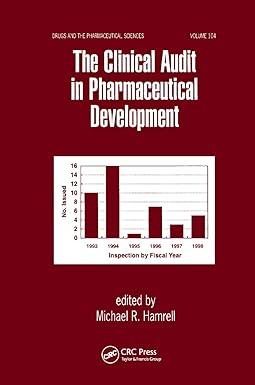Question
Mini-case study: Milos Home Improvement was recently named as an authorized distributor of lawn tractors by the Dear John Company (DJCwhose advertising proclaims, Youll love
Mini-case study: Milos Home Improvement was recently named as an authorized distributor of lawn tractors by the Dear John Company (DJCwhose advertising proclaims, Youll love our tractors so much you wont care if she leaves you for someone whos not so attached to lawn care.) Milos retail network covers the Southeastern United States. You are the newly hired logistics analyst for Milos, and youve been asked to evaluate the companys current replenishment policies for optional accessories to support lawn tractors.
While Dear John tractors are built at a plant in central NC, the accessories carried by Milos are supplied by DJCs distribution center (DC) in Memphis, TN, since these items are built by various manufacturers from around the globe. The current contract terms between DJC and Milos dictate that Milos must arrange and pay for freight transportation to its facilities. Milos currently ships most tractor accessories via truckload (TL) from DJCs Memphis DC to its own DC in Atlanta. Some accessories are shipped via less-than-truckload service, however. For ease of discussion, let us consider only five items, as specified in Table 3.12. Since sales are concentrated in the relatively temperate Southeastern United States, we can assume that aggregate demand for tractors and accessories is reasonably steady across the year. Daily demand, however, exhibits some uncertainty. Although detailed standard deviation data for demand is currently not available, Milos has historically used a coefficient of variation (standard deviation divided by mean) of 0.3 to estimate the uncertainty in daily demand in its past inventory planning. The order fulfillment lead time from the manufacturer DC (DJC) to the retailer DC (Milos) is a fairly consistent 3 days. Both DCs operate 365 days per year. Other important parameters gathered from company records appear in Table 3.12. TABLE 3.12 Data for Exercise 3.14
| item | unit cost | vol (cu ft) | annual demand | current qty order | freight charge per shippment |
| 6.5-bu rear bagger | 250$ | 32 | 6000 | 109 | $776 |
| 3.5-cu ft tow-behind broadcast spreader | 175$ | 27 | 4500 | 129 | $776 |
| 12-V oscillating fan | 18$ | 2 | 9500 | 365 | $776 |
| canopy | 28$ | 1.5 | 5200 | 200 | $646 |
| Double-bucket holder | 12$ | 0.6 | 18500 | 712 | $776 |
| Common Values Annual holding cost rate | 25% | ||||
| Truckload capacity | 3500 | cu ft | |||
| Memphis-to-Atlanta distance | 388 | mi | |||
| Memphis-to-Atlanta TL cost | 776$ | ||||
| Cost to receive order at ATL DC | 10$ |
(a) For each item, compute the economic order quantity. Is the EOQ a feasible order quantity for each item? Why or why not? For any item where the EOQ is not a feasible order quantity, what order quantity do you suggest?
(b) Using your computed or suggested order quantity values from (a), compute the reorder point for each item that achieves an expected target fill rate of 98%. (See expressions (3.16) and (3.20) in the chapter for hints on how to do this.) Your computed reorder points should allow only non-negative safety stock levels.
(c) Given their similar characteristics, you have suggested that the fan, canopy, and double-bucket holder could be ordered jointly in consolidated shipments. Compute the optimal number of orders for this approach. First, do this using the formula developed in the chapter (expression (3.29)), and then as a constrained optimization problem using Excel Solver. Are these solutions feasible?
(d) Since demand is uncertain, using separate (Q, R) ordering policies for the three items considered in (c) is not guaranteed to result in orders that occur at the same points in time. As an alternative, use the optimal order frequency implied by the Solver solution from (c), mentioned earlier, to compute order-up-to levels for those three items for a periodic-review (S, T) system. Your order-up-to levels should be set to achieve a 90% in-stock probability target.
Step by Step Solution
There are 3 Steps involved in it
Step: 1

Get Instant Access to Expert-Tailored Solutions
See step-by-step solutions with expert insights and AI powered tools for academic success
Step: 2

Step: 3

Ace Your Homework with AI
Get the answers you need in no time with our AI-driven, step-by-step assistance
Get Started


